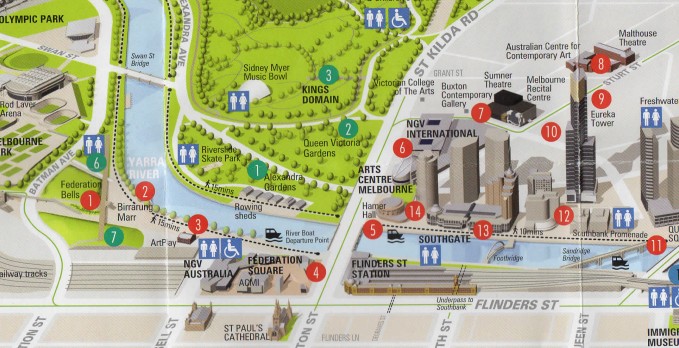Melbourne City Arts Trail (Central Melbourne)

Melbourne's Yarra River Precinct is tailor-made for short, interesting walks on its three great themes: the arts, maritime heritage, and gardens. Each walk is about 90-120 minutes duration, although the wealth of attractions and points of interest along the way can easily fill-in many hours or an entire day.
The Yarra River Precinct is the hub of Melbourne's artistic and cultural scene. Probably nowhere in the world is there such a concentration of high quality visual and performing arts venues, quite apart from a very generous sprinkling of public art and the exciting architecture on display.
For the Melbourne City Arts Trail, start at Federation Bells, on the hill in Birrarung Marr, and follow the red numbers on the map above.
Map with highlighted locations (red dots):

1 The electronically controlled 39 bells of the Federation Field of Bells, installed in 2001, commemorate the Centenary of the Federation of Australia.
2 Deborah Halpern's imposing 'Angel' tiled sculpture (sister piece to Ophelia at Southgate) and the 'Sea Wall' are located on the bend in the river.
3 Birrarung Wilam (River Camp), a work by Indigenous artists Vicki Couzens, Lee Darroch, and Treahna Hamm that interprets stories from local Indigenous communities.
4 Proceed to the architecturally acclaimed Federation Square, opened in 2002. Don't leave without visiting The Ian Potter Centre: NGV Australia, which houses the world's largest collection of Australian Indigenous art. (Free entry - open daily) Also visit the Australian Centre for the Moving Image (ACMI), which depicts the development of Australian film as an art form, and includes some exciting contemporary digital art exhibitions to bring you right into the 21st century. (Free entry - open daily). The Koori Heritage Trust's galleries are also well worth a look (Free entry - open daily).
Walk over Swanston St at the pedestrian lights to the Station, then cross Princes Bridge (1888) to reach Arts Centre Melbourne.
5 You're now in the hub of Melbourne's arts precinct, comprising Hamer Hall (1982; refurbished 2012) and the lattice-spired Theatres (1984). (You may enter the public areas of the buildings.) The street level of The Theatres building features the Australian Music Vault and ARIA Hall of Fame (Open daily ? free.) Sitting on the lawn between Hamer Hall and the Theatres building is Berlin-born, Melbourne artist Inge King's steel sculpture 'Forward Surge' (1981).
6 The imposing National Gallery of Victoria on St Kilda Road (1967) is the home of the Gallery's international collection, which is regarded as the finest in the country. (Open daily - free.)
7 Turn right into Southbank Boulevard to find, side-by-side, Buxton Contemporary (free) Melbourne Theatre Company's Southbank Theatre and the Melbourne Recital Centre, with its showpiece Elisabeth Murdoch Hall.
8 Turn left into Start St. Walk about 500 metres along Start St to experience the distinctive exterior and interiors of the Melbourne Conservatorium of Music, the Victorian College of the Arts, Ron Robertson-Swann's sculpture Vault (1980), the Australian Centre for Contemporary Art (Open daily ? free.) Next door is the Malthouse Theatre, which started life in 1892 as a malting house. Across the road you'll see 'Habitat Filter' (2016).
9 Return back on the west side of Sturt St. Visit Guild at 152 Sturt St, which accommodates the Print Council of Australia, NIDA Melbourne, the Australian Performing Arts Market, and the Guild creative spaces.
10 Turn left when Sturt St meets Southbank Blvd. On the other side of Southbank Blvd is the worksite of the State Goverment's $1.7 billion Melbourne Arts Precinct reimagining project, which will include a new world-leading gallery of contemporary art, plus extensive raised gardens and parklands to connect Southbank Blvd to St Kilda Road near Princes Bridge.
Walk down Southbank Blvd past the Australian Broadcasting Corporation's (ABC) Melbourne studios, through the new linear park, which passes Australia's tallest building, Australia 108. Cross over City Rd at the pedestrian crossing and head to the river at Queensbridge Square.
11 The Red Stairs is a performance space and spanning the river is Sandridge Bridge (1888) with its movable sculptures 'The Travellers' (2005) by Lebanese artist Nadim Karam. They represent the waves of immigration to Victoria since the 1830s. The aboriginal period is represented by the stone and steel sculpture 'Gayip' in Queensbridge Square.
After viewing the bridge and its sculptures, you can return to the city via the river's north bank path, or return to the south bank and head to the Southgate complex.
12 On the way you will see the 'The Golden Bees' by Richard Striger on the north face of the Eureka building and then 'Shearwater' by Inge King. The polished flat stone sculpture on the grass of Southbank Promenade is 'World Within, World Without' by Helen Bodycomb (2010). It depicts the constellations above Victoria. .
13 Explore the artwork at Southgate, including the mosaic-tiled 'Ophelia' (1992) by Deborah Halpern, street art by Melbourne 'Murals' (2023) and free exhibitions on the Upper Level.
14 The tubular sculpture 'Dervish' 1981 is by Australian-American artist Clement Meadmore.
Continue along the river promenade until you reach the base of Princes Bridge. You can either take the steps up to St Kilda Road or use the nearby lift. Cross Princes Bridge to return to the CBD.
This brochure "Melbourne City River Trails" is available at the Melbourne Visitor Centre.
Web Links
→ Melbourne City Gardens Trail
→ Melbourne City Maritime Trail
→ Melbourne City Sports Trail









